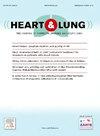The naples prognostic score as a new predictor for heart failure: A cross-sectional study
IF 2.4
4区 医学
Q2 CARDIAC & CARDIOVASCULAR SYSTEMS
引用次数: 0
Abstract
Background
The Naples prognostic score (NPS), a novel nutritional and inflammatory index, holds great promise for predicting the prognosis of heart failure (HF), but research on its association with HF outcomes is limited.
Objective
To analyze the relationship between the NPS and the incidence rate and long-term prognosis of HF.
Methods
Participants from the National Health and Nutrition Examination Survey (NHANES) data were allocated into three groups (group 0 (the NPS=0), group 1–2 (the NPS=1–2), and group 3–4 (the NPS=3–4)) based on the NPS level. Regression analysis was conducted to examine the relationship between the NPS and HF prevalence, and ROC curve analysis was employed to determine the prediction accuracy. The Cox proportional hazards model and Kaplan-Meier survival curves analyzed mortality risk, with subgroup and sensitivity analyses for model stability.
Results
The study included 47,300 individuals (mean age 47.18 years; 51.07% female; 68.86% non-Hispanic white). The HF prevalence was 2.30% (95% CI: 1.66, 3.17). Among 1,581 HF patients, 851 all-cause deaths occurred during a median follow-up of 6.84 years. In groups 3–4, the risk of all-cause, cardiovascular, and cancer mortality was significantly higher (4.18, 4.89, and 16.93, respectively, all p < 0.05) compared to group 0. Furthermore, a significant difference was observed in the association between the NPS and cancer mortality across age subgroups (p < 0.05). In contrast, there was no significant interaction between the NPS and all-cause mortality or cardiovascular mortality in subgroup analyses.
Conclusions
The NPS is a low-cost and easy-to-calculate prognostic score that helps predict the clinical course of patients with HF.
那不勒斯预后评分作为心衰的新预测指标:一项横断面研究。
背景:那不勒斯预后评分(Naples prognostic score, NPS)是一种新的营养和炎症指标,对预测心力衰竭(HF)的预后有很大的希望,但其与HF预后的关联研究有限。目的:分析心衰NPS与心衰发病率及远期预后的关系。方法:根据NHANES数据将参与者按NPS水平分为0组(NPS=0)、1-2组(NPS=1-2)和3-4组(NPS=3-4)。回归分析NPS与HF患病率的关系,ROC曲线分析预测准确性。Cox比例风险模型和Kaplan-Meier生存曲线分析死亡风险,并对模型稳定性进行亚组分析和敏感性分析。结果:研究纳入47,300例个体(平均年龄47.18岁;51.07%的女性;68.86%非西班牙裔白人)。HF患病率为2.30% (95% CI: 1.66, 3.17)。在1581例心衰患者中,851例全因死亡发生在中位随访6.84年期间。3-4组的全因死亡率、心血管死亡率和癌症死亡率均显著高于0组(分别为4.18、4.89和16.93,p < 0.05)。此外,不同年龄亚组的NPS与癌症死亡率之间存在显著差异(p < 0.05)。相比之下,在亚组分析中,NPS与全因死亡率或心血管死亡率之间没有显著的相互作用。结论:NPS是一种低成本且易于计算的预后评分,有助于预测心衰患者的临床病程。
本文章由计算机程序翻译,如有差异,请以英文原文为准。
求助全文
约1分钟内获得全文
求助全文
来源期刊

Heart & Lung
医学-呼吸系统
CiteScore
4.60
自引率
3.60%
发文量
184
审稿时长
35 days
期刊介绍:
Heart & Lung: The Journal of Cardiopulmonary and Acute Care, the official publication of The American Association of Heart Failure Nurses, presents original, peer-reviewed articles on techniques, advances, investigations, and observations related to the care of patients with acute and critical illness and patients with chronic cardiac or pulmonary disorders.
The Journal''s acute care articles focus on the care of hospitalized patients, including those in the critical and acute care settings. Because most patients who are hospitalized in acute and critical care settings have chronic conditions, we are also interested in the chronically critically ill, the care of patients with chronic cardiopulmonary disorders, their rehabilitation, and disease prevention. The Journal''s heart failure articles focus on all aspects of the care of patients with this condition. Manuscripts that are relevant to populations across the human lifespan are welcome.
 求助内容:
求助内容: 应助结果提醒方式:
应助结果提醒方式:


